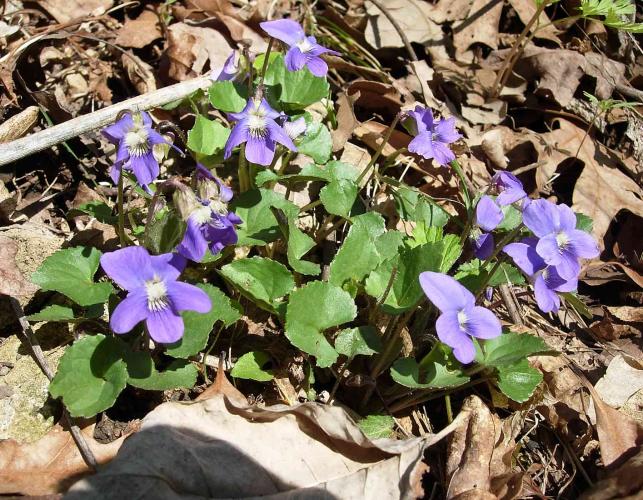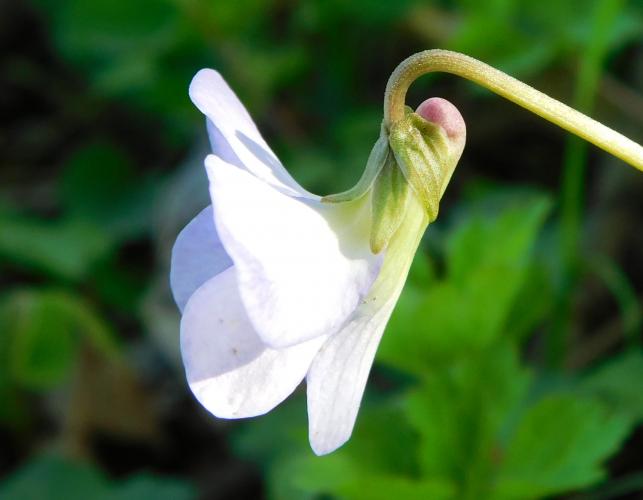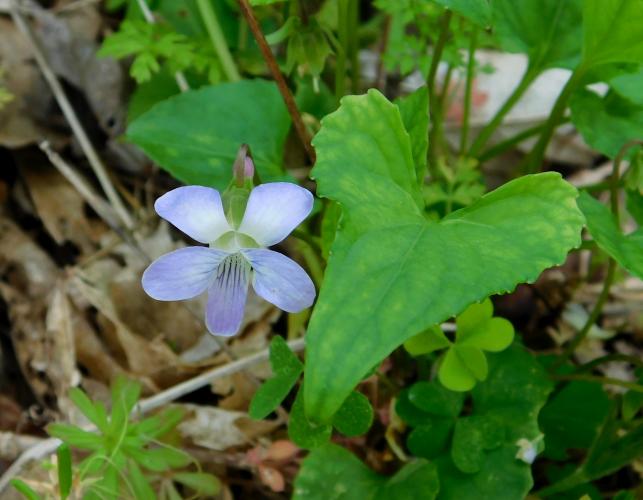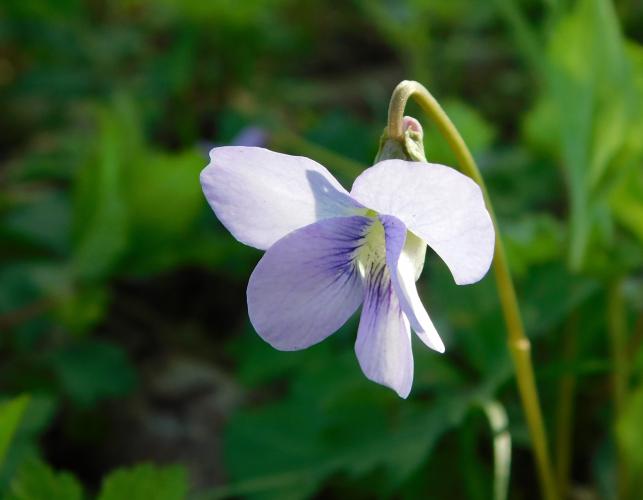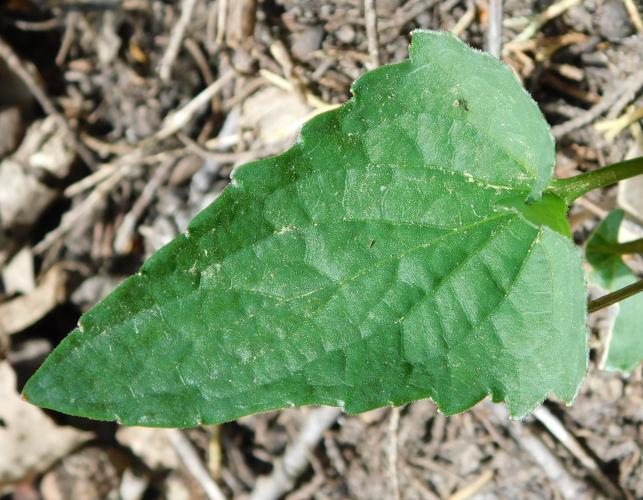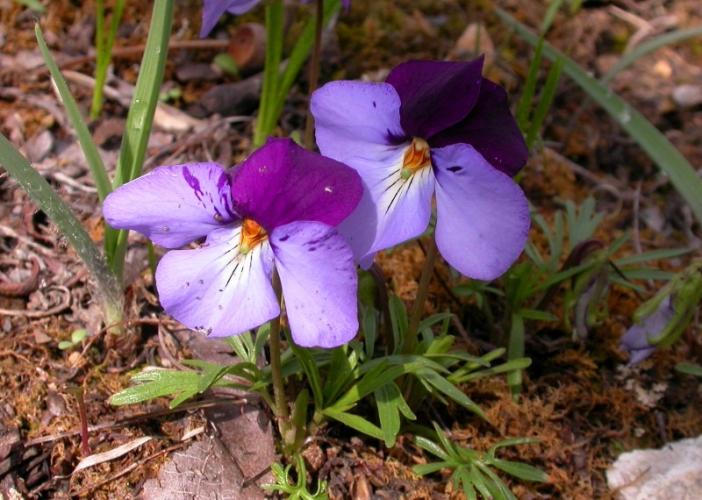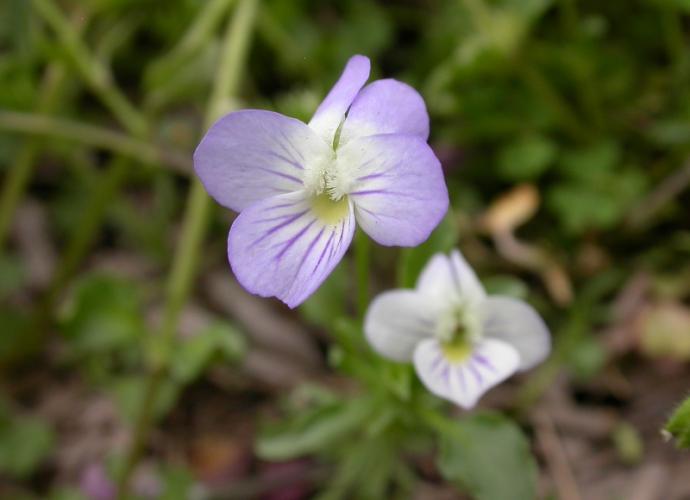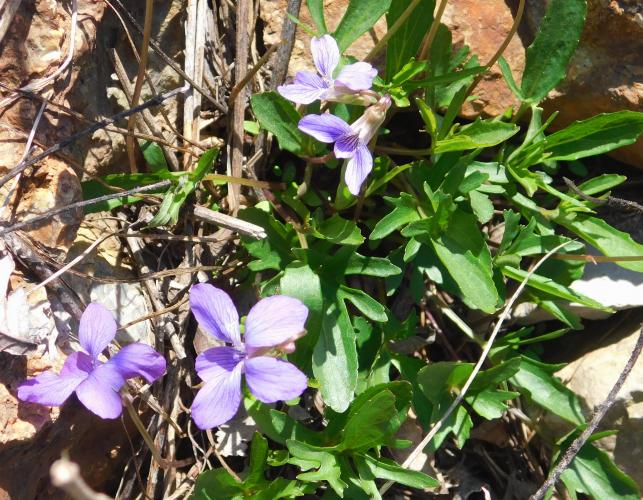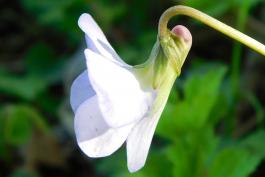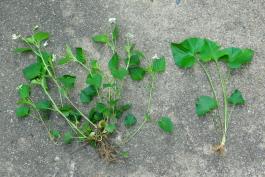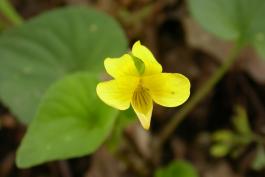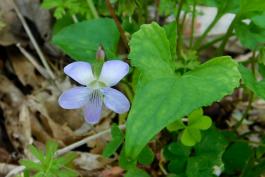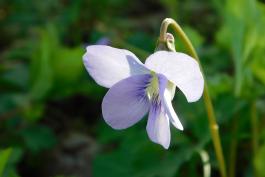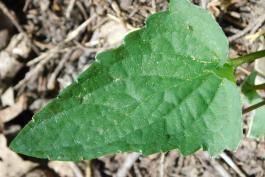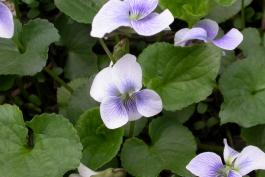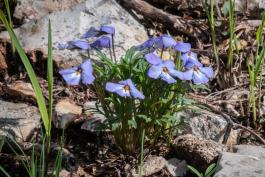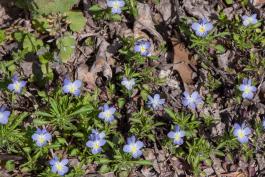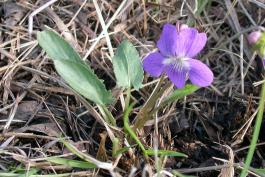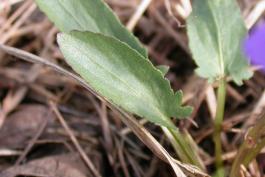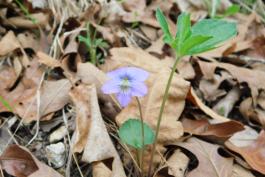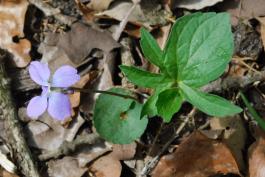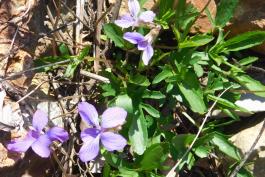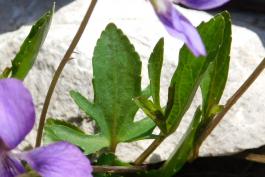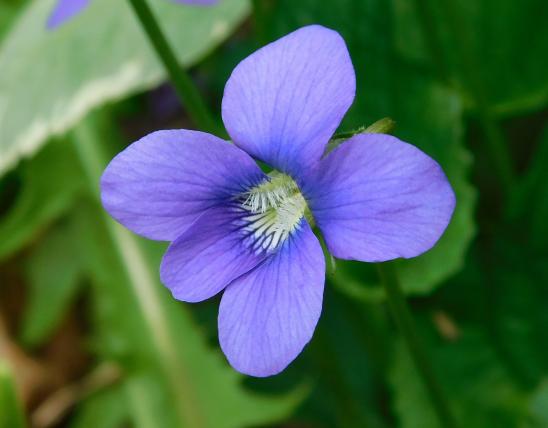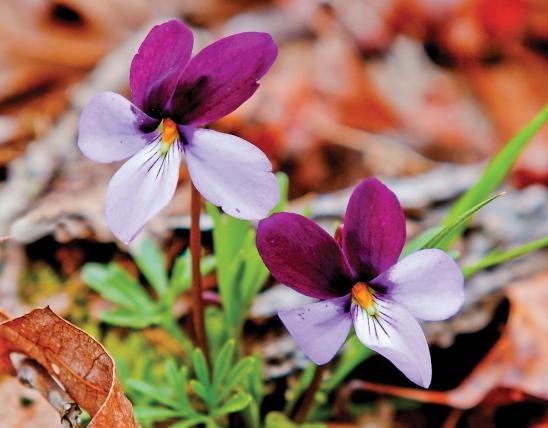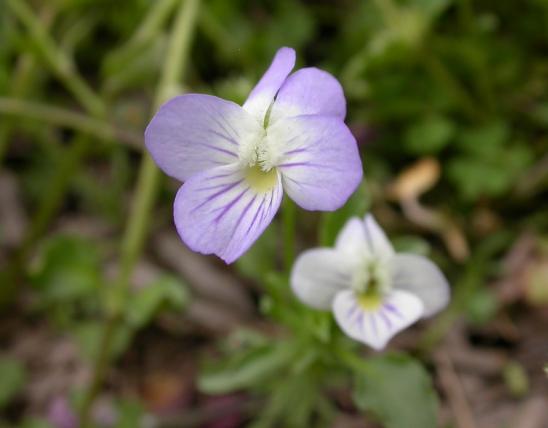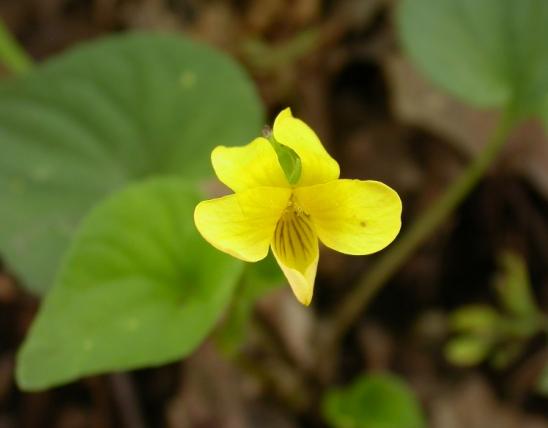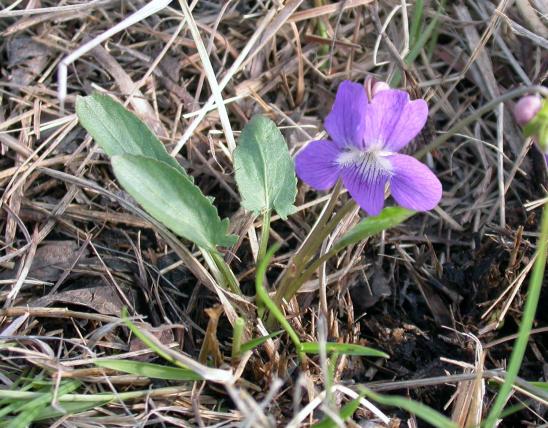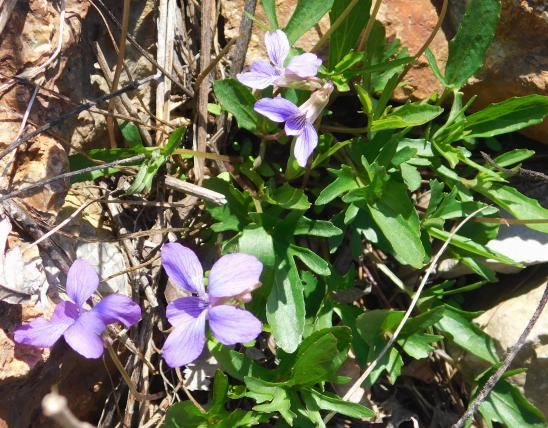
Violets, as a group, are fairly easy to identify, with their colorful five-petaled “faces” so welcome in springtime. Missouri has 17 species. Some are very common while some are rare; many others are scattered or have limited distributions in the state. Many species have purple or bluish flowers, while others are white or yellow, and others have a variety of colors. Some species are confusingly similar. Leaf shape is often a key identifying feature. This page introduces Missouri’s violets as a group.
Plant form. Missouri’s violets are all nonwoody (herbaceous) wildflowers. Most are perennials growing from rhizomes, but some are annuals, with fibrous rootstocks. A big distinction is that some have their leaves and flowers attached to true, leafy, aboveground stems, while others have each leaf blade and flower on its own separate stem that attaches directly to the growth tip of the rhizome, so the separate flower stems and leaf stems appear to come right out of the ground. So one of the first things to notice, when you’re trying to identify a Missouri violet, is whether the plant is "stemmed" or "stemless."
- If you are confused by "stemmed" versus "stemless" violets, it might help to remember that leaf stalks (petioles) are technically part of the leaf, the other part of the leaf being called the "blade." Also, the stalk beneath an individual flower or a flower cluster is called a peduncle. We try to avoid technical terms, thus "leaf stem" and "flower stem" are not the same as a true, leaf- and flower-bearing "plant stem."
Leaves. Violet leaves are most typically heart-shaped (cordate) or kidney-shaped (reniform), with toothed or scalloped margins, but leaves can vary greatly among the species and can be very helpful for species identification. Some species have leaves with unusual lobes that are narrow, wide, or a combination of both. In a few species, the plant produces leaves with different shapes over the course of a season, which can be confusing. Even the ones with unlobed leaves can vary from being mostly round, to being elongated, long-tipped, or lance-shaped.
Flower form. The form of violet flowers is distinctive. First, note that some species have flat-faced, pansy-like flowers, while most typical wild violets have flowers with the petals oriented forward, forming a kind of tube and, often, curling back at the tips. Violet flowers have 5 petals: The lowest petal typically forms a spur containing nectar, and the 2 side petals (lateral petals) typically have a tuft of hairs (“beard”) on the upper (inner) side; the hairs may be uniformly slender, club-shaped, or knob-tipped. The lower petal may be glabrous (hairless) or it may have hairs on the upper surface. These details can be helpful clues for species identification.
Flower color. Flower color can vary, sometimes within the same species. It can be very helpful for identification, as some violets always have yellow, white, or cream-colored flowers and are never purple. The violets that are purplish or bluish can vary in the exact hue (ranging from bluish to reddish purple), or tint (how intense or pale the color) — but don’t be too concerned with exact shades of violet or purple, since many species can exhibit a wide range of hues and tints. Several species that typically bloom in purple hues occasionally occur in white forms. Notice the throat color: some species have yellow throats, and others have whitish-green throats. Several species have dark or purplish veins or streaks on the petals. In Viola missouriensis and Viola cucullata, the purple is sometimes darker where it surrounds the whitish throat, forming a sort of eyespot.
Cleistogamous (nonopening) flowers. In addition to the typical flowers that open and are cross-pollinated, violets also commonly produce flowers that never open and instead fertilize themselves. Such flowers are pale and budlike and usually form low on the plant, below the leaves, and they usually occur later in the spring and summer, after the more showy flowers are fading. These are called cleistogamous flowers (the term, pronounced kly-STAH-guh-muss, basically means “closed marriage”). Among Missouri’s violets, it can be helpful to note whether the stems of the cleistogamous flowers are erect and ascending, arched and spreading, long or short, prostrate or abruptly arched. Three Missouri violets do not produce cleistogamous flowers: V. arvensis, V. pedata, and V. tricolor; a fourth, V. bicolor, only rarely produces them.
Fruits. The fruits of violets are typically ovoid or rounded capsules that eventually dry and split open lengthwise into thirds to release the round seeds. The color, exact shape, and other traits of the fruits and seeds are helpful for species identification.
Identifying Missouri’s 17 Violets
Violet species can be difficult even for specialists to tell apart. Complicating matters, some of the species may interbreed, producing hybrid offspring plants with a blend of characters. This introductory page can’t be comprehensive. Remember that habitat and range are helpful for identification.
Within each of the following subsets, species are listed roughly in order by how common or widespread they are in Missouri.
Violets with true stems (5 Missouri species)
- Yellow violet (Viola pubescens). Native, perennial. Scattered to common statewide, mostly in wooded habitats, moist places, streamsides, pond margins, and edges of pastures and shaded roadsides. Our only truly all-yellow violet, with dark veins. Leaves ovate to heart-shaped to somewhat kidney-shaped.
- Johnny-jump-up, field pansy, or wild pansy (Viola bicolor). Probably native, annual. Common south of the Missouri River, scattered farther north, in glades, grassland margins, bluffs, woodland openings, stream banks, old fields, pastures, margins of crop fields, gardens, lawns, railroads, roadsides, and other disturbed areas. Flowers are flat-faced (pansylike), pale blue to nearly white, with a yellow throat and often darker streaks. Leaf blades and terminal lobes of stipules are entire or have usually 1 pair of blunt or rounded teeth along the margins.
- Pale violet or cream violet (Viola striata). Native, perennial. Scattered to common in the Ozarks, the Ozark border, and the Bootheel lowlands; uncommon or absent elsewhere in the state. Prefers calcareous soils. Often abundant in moist to wet silty loam soils. Flowers are white to pale cream-colored, with darker veins. Leaf blades are ovate to heart-shaped, narrowly angled or tapered at the tip. Our only stemmed violet with white flowers. Even without flowers, this species can be identified by the stipules at the bases of the leaves, which are rather large, leafy, with a fringe of slender, deep teeth or lobes.
- Miniature pansy, viola, Johnny-jump-up, or heart’s ease (Viola tricolor). Nonnative, annual. Uncommon and sporadic when not cultivated; occasionally found reseeding from garden plants, usually in lawns and open, disturbed areas. This flat-faced Eurasian species is a common bedding plant sold at garden centers, available in a variety of colors. It often has yellowish orange and purple on the same flower, typically with a yellow throat. This is one of the parent species of the well-known garden pansy (V. x wittrockiana), which was developed in the early 1800s. Apparently V. tricolor does not persist long outside cultivation on our continent.
- Wild pansy or European field pansy (Viola arvensis). Nonnative, annual. Uncommon in the eastern half of the state, occurring on edges of forests, in old fields, and along railroads. Another flat-faced Eurasian native that escapes from cultivation. It is most similar to V. bicolor, but the flowers have the long, narrow sepals longer than the petals.
Stemless violets with white flowers (2 Missouri species)
Keep in mind that some of the violets that typically have purple or blue flowers occasionally have individuals with white flowers.
- Lance-leaved violet (Viola lanceolata). Native, perennial. Scattered in the eastern half of the Ozarks and nearby parts of the Bootheel lowlands, occurring in fens, acid seeps, marshes, swamps, margins of sinkhole ponds, wet swales in sand prairies; also occasionally on banks of streams and rivers; also moist roadsides and even on rotting logs. Note the limited habitat and distribution. The leaf blades are key: they are lanceolate, longer than wide; the bases are either angled or tapered (not heart-shaped).
- Smooth white violet or northern white violet (Viola macloskeyi spp. pallens; syn. V. pallens). Native, perennial. Uncommon, known in our state only from Ste. Genevieve County. Occurs on bases and ledges of bluffs and banks of streams, on moist sandstone substrates. A Missouri species of conservation concern, ranked as imperiled. Most similar to V. lanceolata and occurs in the same region and similar habitats. Smooth white violet has leaf blades that are distinctly wider than they are long, or about as wide as long. It also lacks throat hairs on both the lateral petals as well as the lower petal. It’s our only stemless, beardless, white violet with unlobed leaf blades that are wider than long.
Stemless violets with purple/blue flowers and lobed leaves (5 Missouri species)
These two stemless purple violets have lobed leaves that are deeply dissected and narrowly lobed (bird’s-foot pattern):
- Bird’s-foot violet, pansy violet, or hens and roosters (Viola pedata). Native, perennial. Scattered to common nearly statewide, but uncommon to absent in the western part of the glaciated plains of northern Missouri and southern portion of the Bootheel lowlands. Occurs on glades, prairies, forest openings and edges, bluff tops, stream banks, sinkhole pond edges; also in pastures, old fields, fencerows, and roadsides. Identifiable by the look of the flowers. A beautiful, flat-faced (pansylike) violet with two color forms: (1) all petals light purple, or (2) light purple on the bottom three petals and dark, velvety purple on the top pair. It can form large displays on glades and dry, poor-soil, cherty road banks in the Ozarks.
- Prairie violet or larkspur violet (Viola pedatifida). Native, perennial. Scattered in the western half of the state; uncommon historically farther east. Occurs in upland prairies, loess hill prairies, tops of bluffs, glades, occasionally bottomland prairies; also along railroads and roadsides. It’s not a flat-faced species; except for its “birds-foot” narrow-lobed leaves, it looks a lot like many of our other stemless blue violets. Note that the central lobe of each leaf is always ternately divided (into threes, with a central lobe plus two sides lobes); this helps distinguish nonflowering plants from V. pedata, whose central lobes are either undivided or bear only one or two irregular short teeth.
The following three stemless purple violets have remarkably lobed mature leaves, and the leaves typically change shape over the course of the season. The earliest spring leaves are typically unlobed, much like many other violets. As the season progresses, the newer leaves grow taller and have progressively weirder lobed shapes, with at least the central lobe relatively wide (usually at least about ¼ inch wide). In late summer, these species may start producing unlobed leaves again. You’ll probably find different leaf shapes on the same plant:
- Arrow-leaved, arrowhead, or arrowleaf violet (Viola sagittata). Native, perennial. Scattered nearly statewide, but uncommon or absent from the Bootheel lowlands and the western half of the glaciated plains of northern Missouri. Occurs in dry prairies, sandstone glades, and edges or clearings of open oak forests, on dry to seasonally somewhat moist or gravelly sand. Relatively widespread in Missouri but apparently nowhere very abundant. In mature plants, the shape of the leaf blade is unique: longer than wide, with a single large, oval or triangular central lobe; additional lobes occur only at the basal 1/3 of the blade and are rather short, less than 1/3 the length of the midvein.
- Cleft violet or three-lobed violet (Viola palmata; syn. V. triloba). Native, perennial. Scattered nearly statewide, but less abundant in the glaciated and unglaciated plains of northern and western Missouri. Occurs in rich upland forests, bases, ledges, and tops of bluffs, banks of streams and rivers, also along railroads and roadsides. Leaf blade shape changes with season; main leaves usually 3- or 5-lobed (or more), usually irregularly cleft, and the lobes may have irregular teeth. The central lobe may be wider than the lateral lobes and may be lanceolate to triangular-ovate. This species is most likely to be confused with V. viarum. V. palmata is distinguished from that species by its hairy leaf blades; also, the cleistogamous flowers/fruits are on short, arched or spreading stalks, the surface dark green mottled with purple.
- Plains violet or wayside violet (Viola viarum). Native, perennial. Uncommon; widely scattered in Missouri. Occurs on banks of streams and rivers, bases and crevices of bluffs, and rarely bottomland prairies; also on railroads and roadsides. Leaf blade shape changes with season and is very similar to that of V. palmata (see above); some botanists consider it a variety of that species; others think it’s a result of violets hybridizing with each other. V. viarum is distinguished from V. palmata by its glabrous (hairless) leaf blades; also, the cleistogamous flowers/fruits are on relatively tall, erect stalks, the surface uniformly green.
Purple/blue-flowered, stemless violets with unlobed leaves (5 Missouri species)
- Common violet (Viola sororia). Native, perennial. Common statewide in a wide variety of natural habitats but also in yards, roadsides, and many other disturbed areas. It is often cultivated; some view it as a weed. It is variable in flower color, ranging from purple to pale bluish, to white, to white with purple spots or blotches. Foliage may be quite hairy to nearly hairless. Most times, when you see a purplish, stemless violet with round or heart-shaped leaves, this is the species you’re seeing. See below to separate from it our less common violets that look similar.
- Missouri violet (Viola missouriensis). Native, perennial. Scattered to common nearly statewide. Occurs mostly in moist or lowland habitats: bottomland forests, mesic upland forests, banks of streams and rivers, sloughs, margins of ponds, lakes, and sinkhole ponds, bottomland prairies, marshes; also ditches, fallow fields, lawns, railroads, roadsides, and disturbed areas. Very similar to V. sororia, and some authorities lump it in with that species. Leaf form and habitat help distinguish V. missouriensis: its leaf blades are longer than wide, unlobed, narrowly triangular to ovate-triangular, truncate (evenly perpendicular to the stem) to shallowly cordate (heart-shaped) at the base, the margins relatively untoothed on the outer third of the blade; otherwise coarsely toothed. Sometimes the flowers have a darker purple border to the whitish throat. Some people have observed that the flowers of V. missouriensis are typically a lighter purple (lilac) than those of V. sororia.
- Blue prairie violet (Viola nephrophylla, syn. V. pratincola). Native, perennial. Uncommon and widely scattered, mostly south of the Missouri River. Lives on banks of streams and rivers, fens, margins of ponds, and other seepy areas; also in mine tailings, lawns, railroads, and roadsides. It is very similar to V. sororia, but it has thicker leaves that are finely, evenly toothed; the early season leaves are smaller and oval, often purplish on the undersides; also, its cleistogamous fruits are uniformly green (not purplish mottled as is usual with V. sororia), on erect, ascending stalks. This species is widely distributed in North America and is especially well-known in the western United States.
- Marsh violet (Viola cucullata). Native, perennial. Uncommon in the eastern half of the Ozarks and in nearby parts of the Ozark border. Lives in fens, acid seeps, and bases of bluffs. In this species, the flowers strongly overtop (rise above) the leaves. The flowers usually have a dark purple border next to the whitish floral throat, resembling an eyespot. The sepals are often noticeably 3-veined and uniformly tapering to very sharply pointed tips. The leaf blades are longer than wide and are ovate to heart-shaped, heart-shaped at the base, the margins finely toothed their entire length or they may be distinctly wider than to about as wide as long.
- Sand violet (Viola affinis). Native, perennial. Uncommon, a Missouri species of conservation concern, ranked as critically imperiled; it was first documented in our state in 2009 in New Madrid County. Lives in swamps, bottomland forests, and shaded levees. It is similar to V. cucullata but is distinguished by having its open flowers about the same height as the leaves. Also, although its long-tapered leaf tips are similar to those of V. missouriensis, it can be distinguished from that species by its leaf blades being more deeply cordate at the base and more finely and regularly toothed along the margins.
Similar species
Missouri has only one other genus in the violet family, and it is represented by only a single species. The green violet (Hybanthus concolor, syn. Cubelium concolor) won’t be confused with any members of the Viola genus. The green violet has erect, aerial stems 15 inches tall or more, with several nodes per stem, the leaves alternate, elliptic or opposite-lance-shaped; with small, uniformly greenish-white flowers. A close look at the flowers reveals their violet-like configuration.
Common names are not reliable indicators of how closely related species are. The well-known houseplants called African violets are unrelated to the violet family. Also, the little spring-blooming lilies called dogtooth violets are unrelated as well.
Height: common violet, marsh violet, Missouri violet, and pale/cream violet can reach around 15–20 inches. Smooth white violet only reaches about 4 inches. The rest fall in between those sizes.
Statewide. Different species have varying habitat needs and regional distributions.
Habitat and Conservation
Habitat varies with species and can be helpful for identifying the different species. Although some species are widespread and live in a wide variety of habitats, others are quite restricted within our state. See the descriptions above for details.
Status
Of the 17 species of violets recorded for Missouri, 2 of them (V. arvensis and V. tricolor) are nonnative/introduced, 1 (V. bicolor) is probably native (possibly nonnative), and the 14 others are certainly native.
Violets are popular in native wildflower gardening.
The smooth white violet (Viola macloskeyi spp. pallens, also called V. pallens) is a Missouri species of conservation concern, listed as imperiled. It is known only from Ste. Genevieve County. This dainty white, beardless violet is limited to cool, moist microhabitats in Missouri and is possibly a relict from long-ago glacial periods.
The sand violet (Viola affinis) was reported for Missouri in 2009 from one location in New Madrid County, and it has been listed as a Missouri species of conservation concern.
Human Connections
Violets are a beloved sign of springtime in Missouri. They are enjoyed by native wildflower gardeners as blooming ground covers or naturalized in woodland plantings or in rock gardens. Though rather small, they are gratifying to grow, since they are valuable to wildlife ranging from butterflies to the variety of birds and mammals that browse their leaves and fruit capsules. Some species are easier to cultivate than others. Bird’s-foot violet, for example, is difficult to transplant from natural settings (so don’t even try). Get starts of these plants from reputable wildflower nurseries.
Some types of violets, especially V. sororia, may be considered weeds in lawns. Yet they are effective native ground covers that provide food for wildlife. As people become more aware of ground water quality and stream health, habitat loss, and plant and animal conservation, native plant landscaping and environmentally friendly “freedom lawns” are becoming more popular.
Pansies and other Viola hybrids and cultivars are very popular bedding plants, and buying a flat of pansies is a favorite springtime ritual for many Missourians.
The attractive flowers of the stemless blue-flowered violets are used to make a beautiful jelly. They can also be candied for unique confections and garnishes, and they can be eaten in salads (though the flavor is bland). The leaves also hold significant amounts of vitamin C and are edible as a nutritious potherb in spring. The young foliage of most stemless blue violets can be eaten raw or cooked, with a mucilaginous texture similar to that of okra. Throw some in with your other salad greens.
Missouri’s native violets are not particularly scented. Elsewhere, however, several species of violets do produce sweet, seductive scents, making them valuable in perfumes, flavorings, and other products. Sweet violet (V. odorata), native to Eurasia, is the species most famous for its use in making flavored syrup, liqueurs, candies, perfumes, and more. It is sometimes cultivated in North America, and in some regions it escapes into natural settings. It is not known to escape in Missouri.
Regarding the scented violets, there’s an odd, “flirty” quality to their fragrance. One of the chemicals involved temporarily desensitizes the nerves associated with our sense of smell, so that getting a good whiff of a sweet-scented violet renders us temporarily incapable of sensing the perfume a second time in quick succession. Let your nerves recover for a few moments, and you can smell it again.
Violets have historical uses globally as medicinal plants, and modern researchers are investigating a wide array of potential pharmaceutical properties.
The common violet, V. sororia, is the official flower of four U.S. states: Illinois, New Jersey, Rhode Island, and Wisconsin.
There’s a community called Viola in southwest Missouri. It was founded in 1894 and apparently was named for a person named Viola. That settlement provided the name to the Viola Recreation Area on Table Rock Lake.
The names “violet” and Viola came to English from French and Latin, but the essential word (viola) has ancient roots going back to languages that preceded both Greek and Latin. Apparently, it was a plant name first, and its use as a color name came second. The Greek version of the word, iodidēs, which also refers to the flower and the color, came into English as the root word for “iodine.” (When iodine crystals are heated, they give off a purplish vapor.) However, when used as the name of a stringed instrument, viola has a different history, having come from Italian and Latin words for a stringed instrument (vitula) and possibly from ancient words for joy and exultation.
If you’re struggling to distinguish between the various stemless blue violets, don’t feel bad. As one Missouri botanist put it, the “taxonomy of the weedy blue violets affiliated with the V. sororia complex remains a tangled mess.”
Ecosystem Connections
Violets are the food plants for the caterpillars of several kinds of moths and butterflies, including some notable, nifty ones: the giant leopard moth, the regal fritillary, plus most other fritillary species, which are all colorful, medium-sized to large butterflies.
Pollination is carried out by various flies, bees, butterflies, and more.
Like many other perennial herbaceous wildflowers, Missouri’s violets help hold the soil, preventing erosion, and provide forage for many grazing animals ranging from rabbits and woodchucks to geese and deer. Many songbirds, rodents, and other animals eat the seeds.
The nonopening, cleistogamous flowers, which typically begin to form later in the spring and summer, are a strategy that helps these rather small wildflowers to reproduce even when larger plants start to cover them, making them more difficult for pollinators to find.
Seed dispersal in violets occurs in two ways. The first is a forceful, mechanical ejection as the fruit dries and pops open. The second involves myrmecochory (mur-muh-co-cory). In this process, the seeds are carried away to new locations by ants. Violet seeds have a special nutrient-rich structure on the outer surface called an elaiosome (ell-eye-uh-soam), which ants find delicious. The ants carry the seeds into their nests and eat the elaiosomes or feed them to their young. The ants then move the uneaten, still fertile portions of the seeds to their nest’s waste-disposal area, where the seeds can germinate in a cozy, protected, nutrient-rich environment.
Though Missouri has about 17 species in genus Viola, there are about 525 species nearly worldwide. Globally, in the violet family (Violaceae), there are about 25 genera, comprising about 1,000 species. The numbers are approximate because botanists are still debating the relationships among the species and their many variations and hybrids. Although Missourians are familiar with members of the violet family as rather small, herbaceous plants, most of this diverse family’s members that live in tropical regions are predominantly shrubs and small trees. Many are vines, too.
